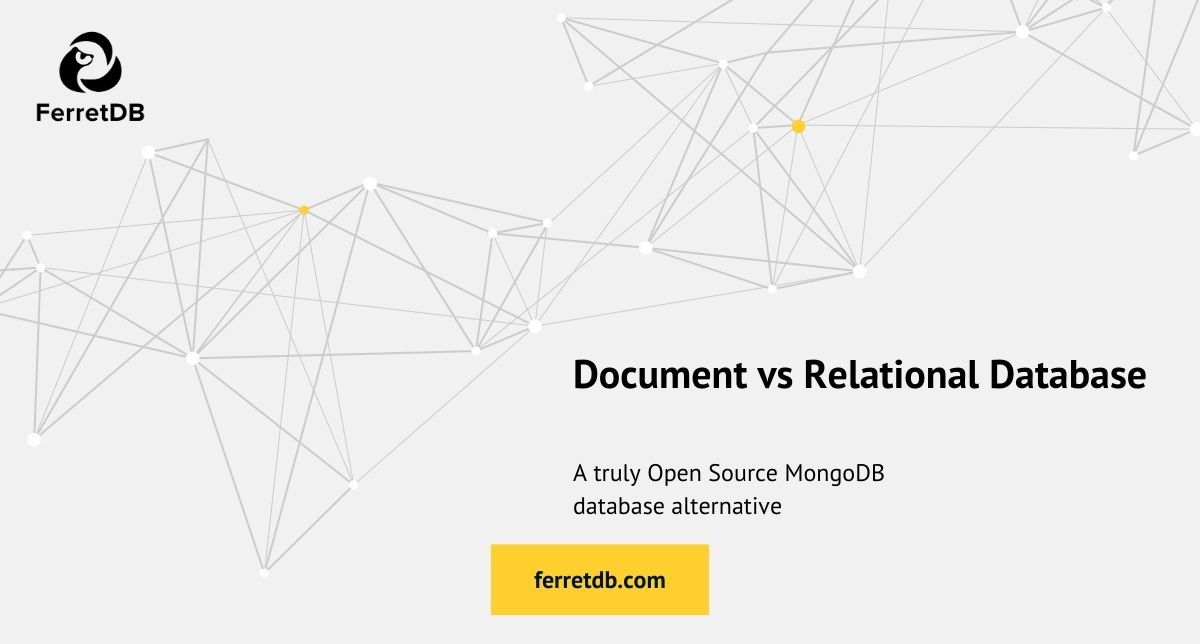Document vs Relational Database: Choosing the right fit for your needs

Before settling on a database for your application, you want to be sure you're picking the most suitable option available. Among the key considerations you'll make is deciding between document database or relational database – which is the best fit?
Each option offers distinct advantages tailored to different application needs. This guide breaks down the differences between relational and document databases, their characteristics, and their use cases. Would your application be more suited for a relational database (e.g. PostgreSQL, MySQL, SQLite) or document database (e.g FerretDB, MongoDB, Couchbase)?
Let's dive in to find out more.
What is a relational database?
Relational databases store data in tables with defined schemas. Each table is composed of rows and columns, where each row represents a data record, and columns hold the data attributes.
Relational databases rely on SQL (Structured Query Language) for querying and managing data, with features designed for consistency, data integrity, and complex querying.
Before we go further into the key features of a relational database, let's get into the history and creation of relational databases.
By the 1960s, information systems and data management had become quite complex as businesses started handling large amounts of data – this cost money, time, and extensive technical knowledge. While they were effective for simple, tree-structured data, they struggled with more complex relationships.
A mathematician and computer scientist, Edgar F. Codd, published a research paper where he proposed a new model for storing data in structured tables. Data can be queried using structured relationships rather than rigid hierarchical structures. Codd's relational model became the foundation for relational database management systems (RDBMS) such as Oracle and MySQL, influencing data storage and access practices ever since.
Take an e-commerce platform that requires order processing, inventory management, and customer relationship management. With a relational database like PostgreSQL, the application can organize data into tables for products, customers, orders, and inventory. The SQL-based relationships between these tables make it easy to manage complex queries, such as retrieving all items ordered by a customer or updating inventory levels when an order is processed.
Key features of relational databases
- Defined schema: Each record must adhere to a predefined schema which helps to ensure data consistency. It consists of rows (elements or records) and columns (attributes) of data that are stored in multiple tables.
- ACID Compliance: Transactions in relational databases are often ACID-compliant (Atomicity, Consistency, Isolation, Durability). ACID is crucial for applications where data accuracy and integrity are essential, such as financial transactions.
- Complex Querying: SQL provides powerful capabilities for complex querying, JOINs, and aggregation. This is why they excel in use cases where advanced data manipulation and multi-table queries are required.
- Vertical Scalability: They typically scale vertically by adding more resources to a single server rather than spreading across multiple servers.
What is a document database?
With the rise of internet applications in the 2000s, the need to handle unstructured and semi-structured data became more pronounced.
Traditional relational databases encountered limitations with unstructured data and scalability, particularly in distributed environments. This led to the development of NoSQL databases, including document-oriented databases like MongoDB, which was released in 2009.
A document database or document-oriented database stores data in a flexible, semi-structured format called documents. They are usually encoded in BSON, XML, or JSON format.
Unlike relational databases with their rigid table-based structure, document databases can include nested structures and varied fields. These systems were designed to meet the demands of rapidly growing web applications, where data structures often evolve quickly and scale is essential.
Let's consider a social media application where user profiles, posts, and comments need to be stored. In this case, each profile or post might have nested information like user details, likes, and comments. Using a document database allows the application to store these complex structures in single unstructured documents that could take any form or data types.
Learn more about document databases.
Key features of document databases
- Schema Flexibility: No predefined schema is needed. Fields can be added or modified as the application evolves.
- Data Encapsulation: Each document encapsulates data as a single entity, reducing the need for JOIN operations, which are common in relational databases.
- Horizontal Scalability: Document databases are typically built to scale horizontally, making them ideal for distributed systems and high-availability applications.
- High Availability: Built with replication and sharding in mind, document databases are often easier to scale and distribute globally.
Comparing document databases and relational databases
Here's a quick comparison of the characteristics of document and relational databases:
| Feature | Document Database | Relational Database |
|---|---|---|
| Schema | Flexible, schema-less | Fixed, schema-enforced |
| Data Model | Document-oriented | Table-based |
| Query Language | Custom (often NoSQL) | SQL |
| Scaling | Horizontal (sharding) | Vertical (scaling up) |
| Transaction Support | Limited or eventual consistency | Strong, ACID-compliant |
| Flexibility | High (adaptable fields) | Low (structured tables) |
| Best for | Dynamic and unstructured data | Structured and highly relational data |
Examples of document databases
The following are some popular document databases that you can consider for your application:
FerretDB
FerretDB is the truly open-source document database alternative to MongoDB, built on PostgreSQL. FerretDB lets you run MongoDB workloads on PostgreSQL using familiar commands and syntaxes.
FerretDB is particularly suited for teams that value open-source databases and want to avoid vendor lock-in. With MongoDB compatibility built in, users can easily migrate their applications to FerretDB without significant changes for most use cases. Here is a guide to help you get started with the FerretDB migration process.
MongoDB
One of the most widely used document databases, MongoDB is favored for its schema-less flexibility, scalability, and support for a broad range of applications from small projects to enterprise-scale systems.
While initially release as an open source database, MongoDB has since switched to the controversial and restrictive Server Side Public License (SSPL). Under this license, MongoDB may require you to release certain portions of your source code under SSPL, particularly in specific use cases like offering MongoDB as a service. You can read more about the SSPL license.
MongoDB's architecture allows it to handle both structured and semi-structured data effortlessly, making it ideal for high-performance web applications. MongoDB queries use a syntax similar to JSON, allowing developers to access and manipulate data quickly.
MongoDB's popularity is amplified by its distributed, horizontally scalable nature, with a community and commercial support that make it an ideal choice for dynamic applications.
Amazon DocumentDB
Amazon DocumentDB is a managed database service from AWS that offers compatibility with MongoDB, and enables users to take advantage of MongoDB-like features with AWS's managed infrastructure benefits.
Amazon DocumentDB is designed to scale and handle large volumes of data with minimal overhead, making it a reliable choice for cloud-native applications. Commands that run in MongoDB can often be directly applied to Amazon DocumentDB, thanks to its compatibility.
DocumentDB is ideal for organizations already committed to AWS services, which means les them integrate their setup with the security and performance benefits of AWS.
Couchbase
Couchbase is known for its low-latency access to data, optimized for real-time applications. It offers a multi-model approach, combining both document and key-value storage, which suits applications where fast, scalable access to data is essential. Couchbase supports SQL-like querying with N1QL, which allows for expressive, flexible queries over JSON documents.
Couchbase's ability to handle data in both document and key-value formats makes it versatile for complex web applications and IoT systems.
CouchDB
Developed by the Apache Software Foundation, CouchDB is a NoSQL database with an HTTP-based API, offering a RESTful architecture ideal for distributed systems. CouchDB uses JSON for documents and HTTP for its API, providing an offline-first approach that automatically syncs when connectivity is restored.
CouchDB's offline-first nature makes it perfect for mobile applications or systems that operate in environments with intermittent connectivity.
Examples of relational databases
The following are some popular relational databases that you can consider for your application:
PostgreSQL
PostgreSQL is an advanced, open-source relational database known for its robust feature set, including support for ACID compliance, complex joins, full-text search, and JSON data types, which extend its functionality. PostgreSQL's support for advanced data types and indexing options makes it suitable for a variety of applications.
PostgreSQL is widely adopted in finance, research, and analytics where both relational and semi-structured data support are required.
MySQL
MySQL is a high-performance, open-source relational database, popular for web applications, particularly with the LAMP stack (Linux, Apache, MySQL, PHP). MySQL's strength lies in its speed and reliability, handling millions of rows efficiently and supporting numerous storage engines for versatility.
MySQL's broad support and numerous plugins make it a versatile option for a wide range of applications, from content management systems to e-commerce platforms.
Microsoft SQL Server
A commercial database from Microsoft, SQL Server integrates well with Windows environments and supports enterprise-grade features such as high availability and replication. It's widely used in corporate environments where integration with Microsoft products is crucial.
SQL Server is often chosen for applications in industries like finance and healthcare, where reliability, security, and integration with Windows services are paramount.
Oracle Database
Oracle Database is known for its advanced feature set and is heavily adopted in enterprise settings where high performance and scalability are critical. Oracle supports advanced SQL functionalities, such as partitioning and clustering, that are ideal for complex, large-scale applications.
Oracle's emphasis on performance and reliability has made it a staple for enterprise applications in sectors such as banking, telecommunications, and logistics.
SQLite
SQLite is a lightweight, serverless relational database commonly used in mobile and desktop applications. Unlike other relational databases, SQLite is an embedded database that operates directly within the application.
SQLite's ease of use and low footprint make it ideal for local storage needs in applications like mobile apps, IoT devices, and standalone desktop software.
Choosing the right database for your needs
To summarize, relational databases excel in structured environments where data consistency and complex querying are essential. Document databases, on the other hand, are often best for applications with flexible schemas, high scalability needs, and data that doesn't require strong consistency across transactions. For document database enthusiasts, check out the Document Database Community – a great platform to learn about recent trends, technologies, and news in the document database space.
If you are looking for a open source document database alternative to MongoDB, FerretDB is a great choice to consider. FerretDB combines the best of both worlds, offering the flexibility of a document database with the reliability and consistency of PostgreSQL. It is a document database with MongoDB compatibility built-in by enabling PostgreSQL or SQLite to run MongoDB workloads.
Check out the FerretDB quickstart guide to get started.
